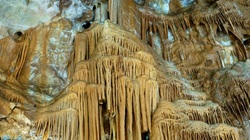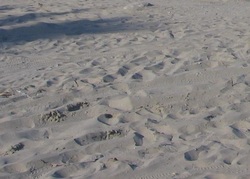|
You may have a little difficulty recognizing the word "patterns" in the title of this post. Hvwoeer, tihs snetence is pborably esay to raed. So what is going on? A friend of mine has been studying the brain. I've been helping him out with some of the maths and concepts. You can read about some of the work at http://www.associatedpatternengine.com/ We have had many thought provoking discussions about how the brain might work, and what is required to simulate the thought process of a brain. The conventional idea seems to be that higher thought revolves around language. I used to accept this argument as it's clear that my mind is constantly 'talking' in words and sentences. But the work on pattern had convinced me that this is only a side effect. Real thought happens non verbally. Here are some examples.
We think the answer is that a brain is a probability-driven fuzzy pattern-matching engine. Everything is made of patterns. Professor Brian Cox has said everything around us is made of patterns. Everything is a pattern. If everything is a pattern, we have to ask, "What is a pattern?", and this is where my contribution fits in with the project. It's not an easy question. Some people will define a pattern something like, "Elements of a set of objects which repeat in a predictable manner." But I think this is incomplete. Here are two examples where there is no predictable repetition, yet an undeniable pattern.
What this means is that a pattern in the most general terms, is a collection of objects which convey information. In my model, a tiled floor consisting of a repeated collection of shades and shapes is indeed a pattern, but this is a special case. This is a pattern which can be defined as an infinite construct yet only using a small number of symbols. The general definition of pattern also includes as a special case, non periodic tiling which can be described using a small number of symbols and a tiling algorithm. An encrypted sentence is an interesting example because it conveys information to one person, and not to others. Therefore it is a pattern to one person, and just random stuff to others. There are other kinds of patterns which fall into the broad definition, one of which is turbulence, and another is the Mandelbrot set. In my definition, even the grains of sand on a beach is considered a pattern. This pattern, however although finite, is simply a very large collection of objects with no predictable repetition. There is no way to exactly predict the position, shape and color of any particular grain of sand in relation to another. Yet we all perceive a sandy beach as a sandy beach and not a cow or a tree. In your brain, when you see the words "sandy beach", this is a two-word pattern which triggers previously experience of a sandy beach. The mental image of a beach will be unique for each person but in every case, the input pattern "sandy beach" is associated with the individual's stored pattern of a beach. This could be a visual pattern, a pattern of smells, or a pattern of how it sounds or the feel of the sand in your hands. These are then strongly associated patterns. There is an input pattern and a set of output patterns. Some input patterns are more highly associated to more and stronger output patterns than others. The word "pAtTeRn" shown in mixed case is not as highly associated as "pattern" without case change. Words are seen as collections of information, we read the whole word in one 'gulp' where the first and last letters are what I call pattern anchors. They help to define the input pattern and focus it to those output patterns most likely associated. This is a good point to address the question, "What is art?" My answer is that art is a pattern. Furthermore, it is a pattern which invokes a significant flow of information from the pattern (the art) to the observer. If this flow of information is large and sudden, then the work might be bold, shocking, ugly, or extra beautiful. It may also invoke a flow of information that is slow and pleasing, constantly revealing new patterns, and new associations the longer you look at it. A work of art which does not invoke a flow of information is weak and unremarkable. The tip therefore for budding artists is to create works which are capable of delivering significant information to the viewer. This can be bold, loud and sudden, or slow and subtle. It can be a combination of the two. A good work of art makes a statement and the 'output' patterns do not necessarily need to be visual.
1 Comment
|
(C) Jeremy Lee 2010, all rights reserved.
Note: I am allowing the blogs in the category 'Book' to be stored for personal use only, but not for distribution or commercial use. Should you wish to reproduce any material, please contact me for negotiations. Categories
All
spOOkspOOk's art is owned by Jeremy. He has practiced drawing and painting for about 40 years, and might get good at it one day. spOOk's art is focused on graphite portraits. Archives
October 2016
|



